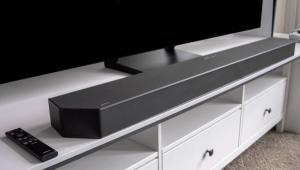Detecting black frames and silence was a way some DVRs could automatically leapfrog a block of recorded commercials. Now, technology will be able to introduce commercials when a user pauses a device and detects the lack of motion and silence. It's like unleashing reverse engineering to take away control we once enjoyed.
Roku Explores an Insidious Way to Serve up Commercials Via Idle HDMI Inputs

The rapid growth of free-ad-supported TV (FAST) seems to suggest so. And now comes word that Roku is exploring a novel (sinister?) way to serve up advertising on your idle HDMI inputs. You can’t make this stuff up. Before delving into Roku’s plan, let’s take a quick look how commercials are finding their way into streaming.
Samsung’s free, ad-based streaming service Samsung TV Plus touts 350+ live channels and thousands of on-demand movies and shows. The LG Channels app on LG TVs boasts more than 300 free channels and free ad-supported programming is available on the The Roku Channel and through the Pluto TV and Xumo free streaming services.
TV with commercials is also now front and center on the major streaming platforms. Netflix has three plans: Standard with ads ($6.99/month), Standard without ads ($15.49/month), and Premium with ads ($22.99/month); the Standard and Premium plans allow you to watch on two or four supported devices simultaneously with the ability to download on two or six devices, respectively.
Disney+ offers the Disney+ Basic plan with ads ($7.99/month) and Disney+ Premium ($13.99/month) with no ads and the addition of Dolby Atmos sound plus a number of bundles with subscription fees ranging from $9.99 a month for Disney+ and Hulu (both with ads) to $18.99 a month for the Legacy Disney Bundle, which includes Disney+ with no ads and Hulu and ESPN+ (both with ads).
And Amazon is now charging an extra for ad-free viewing on its Prime Video service but they instituted the change in a sneaky way: by adding commercials to the existing service and offering the option of paying $3 a month more if you don’t want commercials.
The trend toward watching TV with ads is bolstered by TiVo’s recent video trends survey, which among other things found that 68% of Americans and Canadians say they watch at least one FAST streaming service, an increase of almost 20% over 2020. The study also reinforced the notion that people are becoming more tolerant of commercials. More than half (54%) of households with an annual income of $100K or more are either willing to tolerate commercials or outright in favor of them. Another finding confirmed what we already know: the increasing cost of streaming is a deciding factor in one’s willingness to tolerate ads. Between 2022 and 2023, viewers in the U.S. and Canada cut back their monthly streaming tab by $13 a month, with 24% canceling video on demand services such as Netflix and Disney+.
Amid all of this ad activity, a LinkedIn post by tech strategist and former TiVo/Fire TV exec Ted Malone caught our attention:
"Ads on your idle HDMI inputs? Roku's patent hints at it! Intense TV ads could be a reality, with your gaming consoles or Apple TV potentially becoming an ad canvas. Patent details suggested techniques like monitoring the onscreen movement or extended audio silence to trigger ads. Yet, outrage and interruption of entertainment might be a side effect. Is it a trend test or a near-future reality? Meanwhile, autoscroll ads on Amazon Fire TV [are] already causing a stir!”
The impetus for Malone’s post was a recent report on TheVerge.com that exposed a Roku patent filing relating to a most egregious method for serving up ads to unsuspecting viewers. To quote the application, which is a continuation of a previous patent filing, “This disclosure is generally directed to inserting ads for display and more particularly to inserting customized ads for display based on paused media content.”
Say what?
In other words, Roku is seeking ways to inject ads into TV viewing that go beyond the TV shows and movies you’re watching or video game you’re playing. Any connected device — be it an Xbox console, Blu-ray player, or pick-your-streaming-device — would be vulnerable, creating a potentially lucrative revenue generator for Roku and a headache for viewers.
The filing discusses a number of ways “customized ad insertion” could be implemented over an HDMI connection.
One involves “detecting a pause event in one or more frames (e.g., audio or video frames) received via a HDMI connection, and during the pause event, recognizing content within the one or more frames.” In another, “some embodiments include receiving a control signal via the HDMI connection determining information about the source device, and/or information about the application running on the source device. Some embodiments include determining an ad based on i) the content within the one or more frames, and/or ii) information about the source device and/or information about the application running on the source device. The ad can be displayed on the display device.” (Roku apparently likes the word “embodiment.”)
Insidious?
But wait, there’s more.
Another method involves “analyzing a first video frame or a first audio frame of the one or more frames using automatic content recognition (ACR) technology, and determining a fingerprint, a watermark, or a cue tone corresponding to the first video frame or the first audio frame, where the fingerprint, watermark, and/or cue tone is used to identify information about content…”
Yet another ad-insertion scheme that encompasses gaming would involve “detecting an auto low latency mode (ALLM) from the control signal, where the ad is based on the ALLM” or “detecting a variable refresh rate (VRR) from the control signal, where the ad is based on the VRR.”
The filing is exhaustive and goes into every imaginable technical permutation of using HDMI to get more ads in front of viewers.
In an excellent analysis of the filing, TheVerge’s Chris Welch observes, “Obviously, it’d be very easy for Roku to massively screw this up, interrupt your entertainment, and outrage customers. And a patent itself is no guarantee that this ads-on-every-HDMI-input concept will become reality. But it does follow a recent trend of streaming box (and stick) makers pushing right up against the line of what consumers are willing to tolerate — and testing whether they can quietly move the goalposts. Even Microsoft is dabbling with the same.”
You can read the patent filing in its entirety here. Let’s hope Roku hits the Pause button on this one.
- Log in or register to post comments


For thrill-seekers out there, I've stumbled upon an incredible place online. The level of detail in the graphics left me in awe, and the gameplay? Absolutely immersive! v6bet https://v6betcasino.com/ It's clear to see the dedication and innovation that's gone into this. If you're like me and crave a bit of excitement, you've got to try this site. It's a real game-changer, trust me on this one!

Larger floats that can accommodate multiple people and often feature cup holders or built-in coolers https://poolnoodles.store/.

Larger floats that can accommodate multiple people and often feature cup holders or built-in coolers https://poolnoodles.store/.





























































